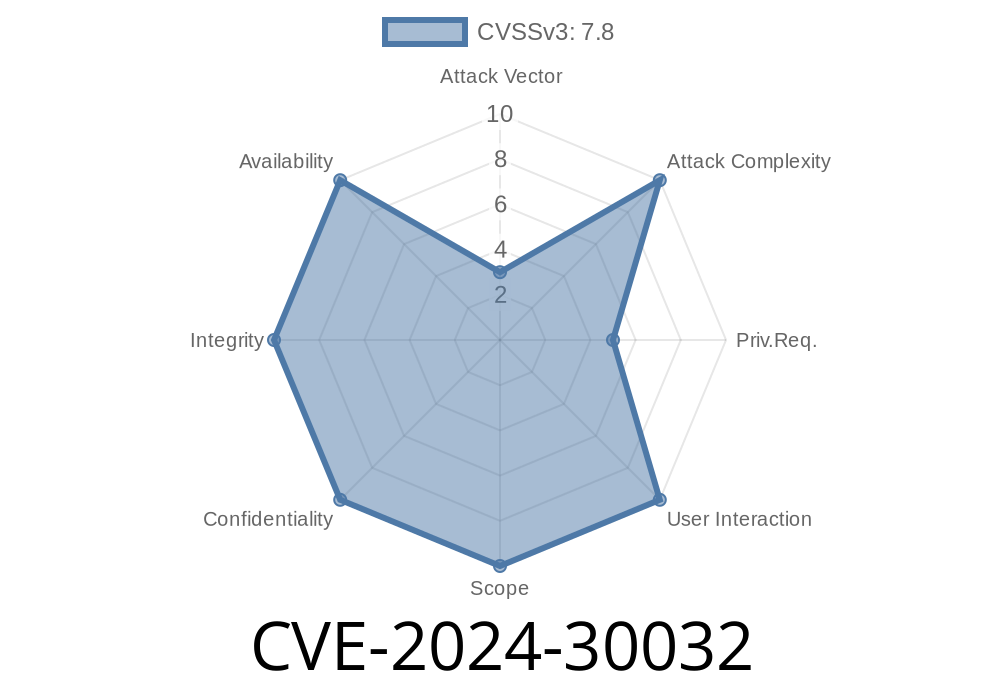In June 2024, Microsoft patched CVE-2024-30032, an Elevation of Privilege (EoP) vulnerability in Windows Desktop Window Manager (DWM) Core Library. While it didn’t get much hype publicly, this bug is a chainable pathway to compromise, and it’s vital for IT pros and enthusiasts to grasp how it works—not just patch and go. In this article, we walk through what the vulnerability is, how attackers can exploit it, the potential impact, and offer practical advice, including a simplified PoC code snippet.
What is DWM Core (dwmcore.dll) and Why Does It Matter?
The Desktop Window Manager (DWM) is a Windows subsystem responsible for the graphical effects in Windows, such as taskbar thumbnails, transparent windows, and Aero Glass effects. It runs in a _privileged_ process (dwm.exe, often as SYSTEM), and interacts with user apps through the DWM Core Library.
Malfunctions or bugs in this component can be catastrophic, as any process sneaking their way into DWM’s privileged context may escape a standard user's security boundary and gain administrative rights.
The Vulnerability: CVE-2024-30032 Explained
According to the Microsoft advisory, this is an Elevation of Privilege issue. The flaw is local—you need to already have access to a Windows user session—but it makes privilege escalation trivial for attackers.
*This bug potentially allows a low-privilege process to execute code as SYSTEM*, giving the attacker full control over the machine.
Microsoft’s details are sparse, but reverse engineers noticed that
- Malicious input can trigger the DWM Core Library to mishandle its process objects (particularly window handles).
- A flaw in access control or input validation lets a standard user inject code or manipulate data structures in a way that DWM will execute attacker-controlled code with SYSTEM-level rights.
No user interaction is necessary—just running a program in the user context is enough, making this ideal for malware.
The typical attack flow for a local attacker would be
1. Dropper: Attacker gets some code running on the target as a regular user (from a phish, infected software, etc.).
2. Exploit: The code abuses the DWM Core Library's bug to create or hijack a DWM-related object (like a window or shared section) and triggers the vulnerability.
Elevation: DWM executes the attacker's code with SYSTEM privileges.
4. Persistence, Lateral Movement, or Payload: The attacker uses SYSTEM access for further attacks (dumping passwords, adding user accounts, disabling defenses, etc.).
Proof-of-Concept Code (Simplified PoC)
*Note: The following snippet is for educational purposes only! Do not use on unauthorized systems.*
Here’s a conceptual C/C++ snippet based on public bug reporting and research
#include <windows.h>
#include <stdio.h>
// A simplified skeleton for how such exploitation might begin
int main() {
HWND hwnd = CreateWindowEx(
WS_EX_LAYERED, // Stack with the DWM
"STATIC", // Use a simple class
"ExploitWindow",
WS_OVERLAPPEDWINDOW,
100, 100, 500, 500,
NULL, NULL, GetModuleHandle(NULL), NULL
);
if (!hwnd) {
printf("Failed to create window\n");
return 1;
}
// NOTE: The real exploit would manipulate window properties here,
// like setting crafted window attributes to trigger the bug in DWM.
// For proof-of-concept, you might interact with undocumented API or
// message handling to trigger the flaw, such as:
// SetProp(hwnd, "DwmDpiProp", (HANDLE)xBADBEEF);
// Next, send custom or malformed data to DWM:
PostMessage(hwnd, WM_DWMCOMPOSITIONCHANGED, , ); // Example, not the real bug!
printf("Window created, DWM attack initiated. Check for escalation.\n");
// Normally, after exploit you would check if you have SYSTEM privileges
system("whoami");
// Clean up
DestroyWindow(hwnd);
return ;
}
To make this real, an attacker would fill in the gaps, possibly using reverse engineering tools to find the right code path in dwmcore.dll.
Links & References
- Microsoft CVE-2024-30032 Security Advisory
- SecurityWeek: Microsoft June 2024 Patch Tuesday
- NVD Entry for CVE-2024-30032
- SandboxEscaper's Notable Windows EoP Writeups (for general context on Windows EoP bugs)
Impact and Risks
- Affected Windows versions: Windows 10, 11, Windows Server 2022 (see official guide for affected versions)
- Any unpatched system is exposed to privilege escalation if a user lands even low-level code execution on it (e.g., via malware, RDP, local access).
- Exploit code has already been developed privately and may surface in pentest tools and malware campaigns soon.
Conclusion
CVE-2024-30032 is another wake-up call about the dangers lurking inside Windows’ legacy graphical subsystems. Even a “simple” local vulnerability can be a disaster when it lets any user pop SYSTEM. If you manage Windows systems, patch now and keep an eye on future DWM-related advisories. Attackers are creative, but basic patching and good security practices go a long, long way.
Timeline
Published on: 05/14/2024 17:17:04 UTC
Last modified on: 06/19/2024 20:58:42 UTC
